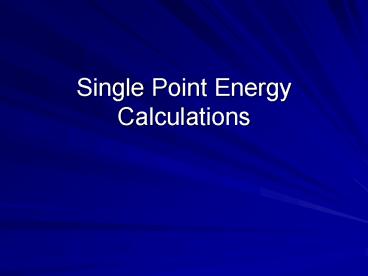Single Point Energy Calculations - PowerPoint PPT Presentation
1 / 9
Title:
Single Point Energy Calculations
Description:
... Valence - Zeta. Most Basis Sets are double or triple zeta in ... Density Fitting Basis Sets have multiple Zeta Core - DZVP, TZVP. Basis Set Interpretation ... – PowerPoint PPT presentation
Number of Views:269
Avg rating:3.0/5.0
Title: Single Point Energy Calculations
1
Single Point Energy Calculations
2
Two Main Type of Basis Functions
- Plane Wave - Sine and Cosine Functions - Not used
in Gaussian - Atomic/Slater/Contracted Gaussian Orbitals - Used
in Gaussian
3
Why atomic like orbitals?
- Two atoms far away almost exactly the same as two
individual atoms. - Two atoms close together can be thought of in
pieces. - Sum of potentials should lead to sum of density.
4
What is a Contracted Gaussian?
5
Flexible Valence - Zeta
- Most Basis Sets are double or triple zeta in
valuence - allows breathing - Possible basis sets exists that are 4,5 6 zeta.
- Single Zeta falling out of use.
- Density Fitting Basis Sets have multiple Zeta
Core - DZVP, TZVP
6
Basis Set Interpretation
- What does 6-31G(d,p) mean?
- 6 is the contraction of core orbitals.
- 31 means that valence orbitals are represented by
two orbitals one contracted 3 times, one not
contracted. - First sign means 3s orbitals on heavies
- Second sign means 2s on H
- (d,p) are polarization on heavies and lights
respectively
7
Effective Core Potentials
- Necessary Evil
- LANL2DZ one of many
- Takes into account relativistic effects
8
For More Information
- Http//staff.science.nus.edu.sg/chmbrpa/Basis20S
ets.ppt
9
Homework
- Pick and important molecule from your research.
Build it and perform a single point energy
calculation. Consider carefully Basis Set and
Method. Take time to look through the results.
What insight do you gain? - Work on problems from Ch2.
- Read Ch 2/3.

